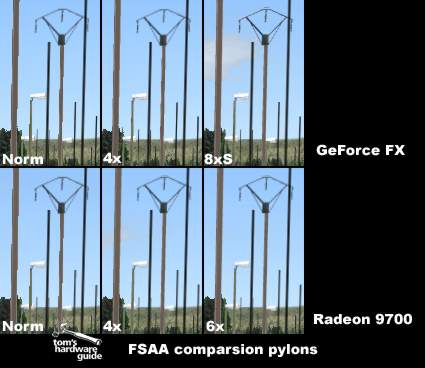Strike Force: The new ATI Radeon 9800, 9600 and 9200 Series
FSAA, Continued
Click image for uncompressed bmp version.
This image shows the greatest drawback of NVIDIA's "Ordered Grid" antialiasing. Where the Pylons still show jagged edges in the FX's 4x mode, ATi's 4x "Jittered Grid" AA all but eliminates them. In 6x, the edges are practically picture perfect. NVIDIA's 8xs mode is an interesting mix, since its combines 4xMultiSampling with 4xSuperSampling. While the grid-like structure of the pylons is drawn much more sharply, it also looks less detailed and shows visible aliasing artifacts.
Max Quality
For those of you who would like to get an impression of the maximum attainable image quality of each card in this game, we have compiled the screenshots in an easily downloadable zip archive:
Image Quality Conclusions
Basing our conclusions on the currently available drivers, we can surmise that the Radeon 9700/9800 is superior to the GeForceFX in both antialiasing and anisotropic filtering. To be fair, NVIDIA's driver still seems to have some problems that are currently holding it back, as the lack of a difference between the different anisotropic filter settings show. Rest assured that as soon as NVIDIA releases a new "final" driver for the FX, we'll be back in the lab to bring you an extensive image quality comparison between the two cards. NVIDIA's 8xs mode, which is not really true 8x AA but a combination of 4x SuperSampling and 4x MultiSampling, offers no advantages worth mentioning. Since it also proved very slow, we strongly question the usefulness of this mode. ATi's 6x mode, on the other hand, offers visible image quality improvements - at least judging from the screenshots.
Get Tom's Hardware's best news and in-depth reviews, straight to your inbox.
